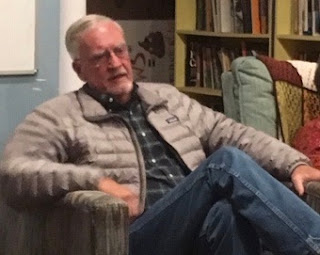The Rev. John Fife says it was all the fault of Jim Corbett, a Quaker and
rancher in the Tucson area. In fact, he says, almost all the good trouble he
has gotten into in his life is because of those Quakers. It all started one day
when Corbett confronted John about two times when the church was challenged to
live out the biblical call to welcome the stranger. The first was the abolitionist
movement of the 19th century which was empowered by the church. The
second was in Nazi Germany in the 1930s and 40s when the church utterly failed
to defend the poor and powerless Jews that led to the Holocaust.
Then Corbett said that the Salvadoran refugees fleeing the
Salvadoran civil war in the 1980s are the next challenge to the church. John
explained that Corbett asked if he was ready to get involved for the purpose of
saving lives. John confesses that he tried to dodge the question saying, “I’ll
pray about it.” Well, as we all know, the Rev. John Fife did get involved,
deeply involved in the Sanctuary Movement in the 1980s. John, Corbett and many
others began an “underground railroad” throughout the country to more than 500
sanctuary congregations. This eventually led to many of them, including John,
being indicted and convicted of harboring and transporting “illegal aliens.”
 John explained that they realized that they should not call
their work “civil disobedience” because they didn’t believe they were breaking
the law; it was the federal government that was breaking the law by refusing to
provide asylum to refugees from the Salvadoran war. The reason the government
was unwilling to provide asylum was because the Reagan administration was
supporting the dictatorship of El Salvador and providing asylum would force the
administration to admit that the Salvadoran government was responsible for gross
violations of human rights. Consequently, all requests for asylum from
Salvadorans were denied and many were repatriated to the country only to be
executed or disappeared.
John explained that they realized that they should not call
their work “civil disobedience” because they didn’t believe they were breaking
the law; it was the federal government that was breaking the law by refusing to
provide asylum to refugees from the Salvadoran war. The reason the government
was unwilling to provide asylum was because the Reagan administration was
supporting the dictatorship of El Salvador and providing asylum would force the
administration to admit that the Salvadoran government was responsible for gross
violations of human rights. Consequently, all requests for asylum from
Salvadorans were denied and many were repatriated to the country only to be
executed or disappeared.
The alternative description that John and Corbett came up
with was “civil initiative” which they define as “the legal right and
responsibility of every citizen to protect the victims of human rights
violations when the government violates human rights.” The Sanctuary Movement
ultimately sued the Attorney General of the United States for failure to uphold
US asylum law. With the threat of depositions being exposed to the public, the US Attorney General promised
to begin upholding US asylum law and withdraw sentencing for those who had been
convicted.
But the question which the church must answer is this, are
we ready to welcome the stranger? Are we willing to commit ourselves to “civil
initiative” again in order to protect the victims of human rights violations
when the government violates human rights?

No comments:
Post a Comment